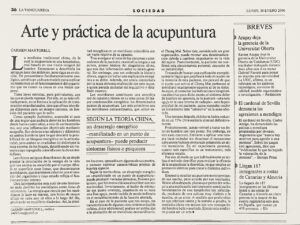ART AND THE PRACTICE OF ACUPUNCTURE (La Vanguardia, 30-1-2006)
Traditional Chinese medicine, in which acupuncture is used for treatment, is based on an integral vision of mankind. The first accounts were described 2 millennia ago, but they are still evolving. From a fundamentally analogical thought process, it constitutes a great model for explaining disorders in the functioning of the body that are not caused by an organic injury. It has strict, yet versatile laws, from which you can reason with. For this, in its most refined practice, it is not limited to simply standardized treatments, but offers more than one approach to the same symptom, depending on the patient’s condition.
To give an illustrative example, I will explain a case of a woman who complained of shoulder pain for the past four years, stemming from an injury, with inflammation found through an ultrasound. Her pain was atypical and different in both shoulders (ruling out the possibility of a energetic blockage in the joints), but both radiated to the outside of the arm, describing a trajectory whose topography ran along a “meridian” (in this case, shousanjiao/TB).
The ancient Chinese described, in a very precise way, the circulation of energy that animates us: its path over the body’s surface, drawing lines called meridians, that maintain a relationship with the inside of the body and whose condition reflects how well it is functioning. Another more subtle interpretation of this phenomenon is described as a locus of “resonance”.
The energy that circulates on the meridians does so in tides, with certain times of day showing a greater flow in each one as the day goes on, generating a dynamic equilibrium. Thus, when one meridian has a plentitude of energy, it coincides with a relative emptiness in the opposite area.
After finding out the rest of the symptoms and history of the patient, I examined her tongue and her pulses, basic pillars of Chinese medicine diagnosis, that gave us information about the patient’s general well being. However, once the clinical history was in order, I continued without finding an energetic explanation for her pain. Also, there was a negative feeling that upset me with this patient. She seemed to be bothered by my inquisitive and detailed examination.
The meridians are made up of a complex web of channels, and have within them areas of a high energetic concentration named: “acupuncture points”. The most primitive of these points are the extraordinary meridians, that have points of connection with the others and that seem to express basic and primary characteristics of our species.
According to Chinese theory, an energetic disruption – manifested in an acupuncture point – can produce various symptoms, both physical and psychological, that the classical texts describe with great attention to detail. Inversely, the fact that stimulating this specific point, inserting within it a thin needle, will incite, in an indirect way, the reestablishment of the altered body function.
In the discussed case, the characteristics of some of the other symptoms (severe headaches, abdominal pain) can be attributed to an alteration in an Extraordinary meridian: Chong Mai. Along this meridian, considered a great organizer, may resonate an alteration in energy, due to important changes in the life of the subject, which they are unable to integrate (later, the patient confirmed this personal circumstance to me, which justified her irritability).
In trying to find a logical energetic explanation, I found that the point that activates Chong Mai (Sp4) belongs to the meridian exactly the opposite of her pain (zutaiyin/SP). Even so, after consulting the therapies described in classical texts for this point, the symptom “shoulder pain” did not appear, I placed the needles (just one on the inside of each foot). My patient was perplexed, as she expected to receive a more “intensive” treatment in the affected area. One week later, the pain had reduced by 75%. After one additional session, it was eliminated completely.
Probably, I will never again treat shoulder pain with the SP4 point. However, in this specific case, limiting the application to a standard local treatment without disarming the underlying mechanism would have only procured transitory relief. In my personal experience the more specific the treatment, the more efficient the result. For this reason, the habitual way of evaluating acupuncture is distorted by the scientific method, as it employs an identical protocol to treat different individuals.
I started to study Acupuncture underestimating its theories, but attracted to its results. Twenty years later, I believe that expecting to reduce the fundamentals of a treatment so sophisticated down to strictly one somatic explanation, a product of our very different culture, is an error. As I go deeper into its cryptic texts and submit them to tests, Chinese medicine captivates me with a beautiful and wise conception of mankind. To practice it could be considered an art.
